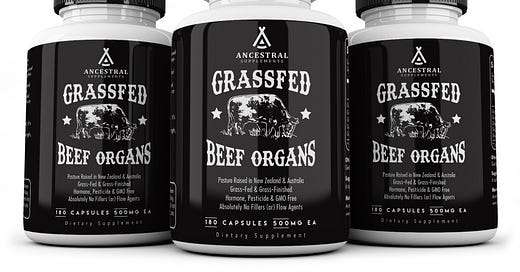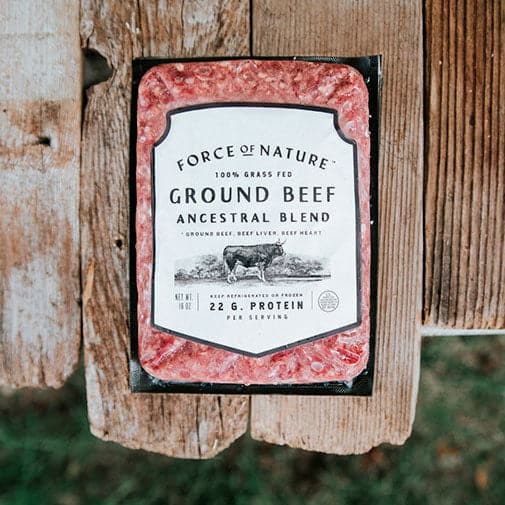Eating Organs the Easy Way
The history of eating organs, their nutritional benefit, & how to eat them when you can't stand the taste
The most nutrient-dense thing we can eat isn’t muscle meat like ribeyes or filets (although they tend to be the tastiest). No, the most nutrient-dense food known to man is organs.
There is a reason why lions, bears, and wolves immediately eat the heart and liver after making a kill. There is a reason our early ancestors gave the strongest warrior of the tribe the first crack at the organs of a kill. For animals and humans fighting to survive, organs give them the best chance to see the sunrise the following day.
It’s fascinating how far we Americans have strayed from eating organs - though not surprising when you observe the health of the nation. For as much access to anything we’d like on the menu, the United States doesn’t even make the top 25 in the 2022 list of the world’s healthiest countries. Maybe if Americans incorporated more organs into their diet like other cultures do, we’d be on this list.
Organs in other cultures
Mexican families like Sebastian’s eat a soup made with a cow’s stomach, called Menudo, on New Year’s Day. Stomach, also known as tripe, is high in vitamin B12, selenium, zinc, calcium, and iron. Eating Menudo is a celebration, a way to start the year off with a meal rich in nutrients.
Pate is a recipe made often in French and Belgian cuisine. It is made of the liver as well as other various animal parts, usually from a pig. Pate is often considered a delicacy for wealthy people. Probably because it is high in vitamin B12, vitamin A, and riboflavin!
Asian cultures cook up traditional dishes such as blood sausage, braised intestines, and stewed lungs. They tend to eat organ meats in soups and stews like we do muscle meats.
If other cultures have been eating organs for hundreds of years, why are Americans so afraid of them?
Organs in America
I came across an interesting Reddit thread detailing the history of organ meat in America.
To summarize, many groups did eat organ meats, but not middle-class white Americans. Organ meats are still popular in Southern cuisine today because the recipes have been passed down among the African American communities. These recipes date back to a time when rural families couldn’t afford the more “prized” parts of the animals and were able to not just get by, but thrive from the organs that others considered throwaway food.
Interestingly enough, during both world wars, Americans were encouraged by the government to utilize the whole animal and consume organ meats. Propaganda focused on getting the middle class to adopt this new diet.
In the January 1943 issue of LIFE magazine, an article on “variety meats”, wrote:
For no good reason most Americans wrinkle their noses at the idea of any of the functional organs of otherwise edible animals. Yet tripe, kidneys, tongue, heart, liver, and the other “variety meats” shown on the following pages are not only rich in nutritive value but, when properly prepared, are among the tastiest dishes known.
While recipes for organ meats were shared among cooks, propaganda still lacked the proper imagery. They were still showing people pictures of steaks rather than organs! Thus, after the war, none of the organ eating seemed to last.
Organs now
I’ve been shopping at a local butcher shop now for years. I have seen the price of liver and other organs slowly increase. Just a few years ago nobody would touch them. Now, education is coming out about how good they are for us. And with that comes a rise in price!
As far as how to eat it once you find it, that’s a different story. Personally, I have never been one for eating the organ raw or even slightly cooked. While I do want to work on training my palette, how to cook organs in a way I enjoy isn’t something I’ve been able to figure out.
I think I’m still a bit scarred from cooking up an elk liver. Sebastian and his cousin had killed an elk last fall, and we had a huge liver sitting in our freezer with no idea how to prepare it. We finally decided to cook it for dinner one night using a traditional liver and onions recipes. We even soaked it in kefir overnight to help draw out some of the metallic taste.
Behold, it still tasted like straight-up iron. Apparently, elk livers are one of the strongest tasting livers out there… so probably not the best place for us to start. Fortunately, since then, I’ve found other ways to add organs into my diet that better suit my lifestyle and palette.
Because let’s be honest, most of us can’t decide to eat liver one day with no problem. It takes getting used to!
Easy ways to add organs to your diet
You can benefit from the nutritional value of organs without having to plug your nose and bear the taste. Here are the two ways I like to add organs to my diet:
Ancestral Supplements
This brand has every type of organ you can think of, desiccated into capsules. The capsules allow you to swallow the pills without tasting the organs. If you can’t swallow large pills, you can always open the capsules and empty them into a smoothie or hot coffee.
My personal favorite is the liver capsule as well as the organ blend. Both act as nature’s multi-vitamin. One of the reasons organs are so powerful is because they are naturally full of all the vitamins we lack in. But, unlike other supplements, they are found in their natural form within organs. This means our bodies are better able to absorb the nutrients.
I noticed a dramatic growth in my nails and hair when I first started taking these. I also experienced way more energy than I was used to. I’ve been taking them for the last 3 years because they’ve made me feel so great!
Force of Nature Ancestral Blend
Another awesome company, Force of Nature, creates an “ancestral blend” of their meat which consists of half muscle meat, and half organs. My personal favorite is the bison blend, made from bison that is grown on their ranch in Texas (which we’ve actually visited!). While the meat does have more of a metallic flavor than your typical ground bison, it is way more manageable than eating the organs by themselves.
I think it tastes great made into meatballs and slathered in red tomato sauce. This helps to take away the metallic taste. Be sure to add lots of garlic and onions to complement the taste!
Now you can ditch your multi-vitamin that contains weird additives, unnatural forms of vitamins, and fillers for some real organs. Slowly start integrating ancestral blends into your normal ground beef supply. If you want to uplevel your health, you need to start somewhere. And that somewhere is here.
Take action: Order organ supplements and begin implementing them into your diet. Or, make a classic recipe such as liver and onions or pate using grass-fed liver from your local butcher.
If you enjoyed this post, please share it with someone struggling with their health. You never know what piece of advice could be a game-changer for them.
Don’t forget to subscribe and check back in next Sunday for a discussion on the importance of being strong (a practical guide, with exercises).
Have a great day!
Madison






A good primer article on organ meats. We Americans seem to have forgotten them, as many of our grandparents before us grew up eating these nutrient-rich foods, a staple food in many culture throughout the world.
Favorite quote, "For as much access to anything we’d like on the menu, the United States doesn’t even make the top 25 in the 2022 list of the world’s healthiest countries. Maybe if Americans incorporated more organs into their diet like other cultures do, we’d be on this list"